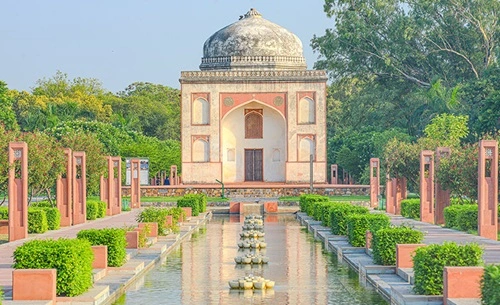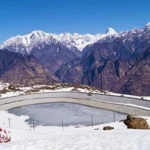Sunder Nursery, a heritage garden located near Humayun’s Tomb in New Delhi, has quickly become a beloved spot for both locals and tourists. Spread across 90 acres, it’s a unique blend of history, horticulture, and ecological restoration. Once an abandoned and underutilized space, Sunder Nursery has been transformed into a lush, beautifully landscaped garden filled with ancient monuments, native plants, and vibrant flower beds. This green haven is perfect for anyone looking to experience Delhi’s rich heritage, cultural history, and biodiversity all in one place.
Timing your visit to Sunder Nursery can significantly impact your experience, as the garden offers different seasonal attractions and activities. From cooler winter months with floral blooms to monsoon greenery and sunny spring picnics, each season brings something special to this iconic landscape. Here’s a guide to finding the best time to visit Sunder Nursery for an enriching experience.

Exploring the Allure of Sunder Nursery
Sunder Nursery dates back to the 16th century, originally developed as a Mughal garden complex. Today, it has been revived by the Aga Khan Trust for Culture, with careful landscaping that incorporates native species, lotus ponds, and carefully restored monuments. It’s also part of Delhi’s UNESCO World Heritage site, Humayun’s Tomb complex. The garden houses several Mughal-era structures, such as the Sunder Burj, Lakkarwala Burj, and Mirza Muzaffar Hussain’s Tomb, blending history with a serene natural environment.
Visitors can also enjoy diverse plant collections, rare tree species, butterfly-friendly plants, water bodies, and a Bonsai House, making Sunder Nursery an oasis of tranquility in Delhi’s bustling landscape.
Best Seasons to Visit Sunder Nursery
1. Winter (November to February)
Winter is the most popular season for visiting Sunder Nursery, as the weather in Delhi is cool and pleasant, with temperatures ranging from 5°C to 20°C. The cooler months allow visitors to explore the gardens comfortably, taking leisurely strolls along the paths and sitting by the lily-filled ponds. Winter mornings are particularly magical, with mist floating over the garden and soft sunlight filtering through the trees.
One of the highlights of winter at Sunder Nursery is the vibrant floral display. Flowering plants like roses, marigolds, petunias, and pansies are in full bloom, adding a riot of color to the landscape. The nursery’s well-maintained flower beds and seasonal floral arrangements make winter an ideal time for nature and photography enthusiasts. The early hours offer fantastic lighting conditions for capturing the garden’s beauty and its historic monuments.
Additionally, winter weekends at Sunder Nursery often feature cultural events, live music, and food festivals, providing visitors with a complete cultural experience. From classical music performances to art exhibitions, these events draw a lively crowd and offer a unique blend of culture and leisure. If you plan your visit on a Sunday morning, you may catch the famous Sunder Nursery Farmers’ Market, which features organic produce, artisanal goods, and local handicrafts.
2. Spring (March to April)
Spring brings warmer days to Delhi, with temperatures ranging from 15°C to 30°C, making it another great season for visiting Sunder Nursery. The garden bursts into bloom with a variety of flowers like bougainvillea, cosmos, and dahlias. The lush greenery and vibrant flowers create a stunning backdrop for picnics, walks, and photography.
Spring at Sunder Nursery is also a fantastic time for families, as the garden’s vast open spaces and shaded areas provide a relaxed environment for outdoor activities. The Bonsai House and butterfly-friendly plants attract various butterfly species, making it a delightful experience for nature enthusiasts and children alike. As temperatures increase towards the end of April, it’s advisable to visit in the early mornings or late afternoons to enjoy the pleasant weather.
During this season, Sunder Nursery hosts occasional educational workshops on topics like gardening, botany, and biodiversity conservation, offering visitors a chance to learn about the rich flora and fauna that make the garden unique.
3. Monsoon (July to September)
The monsoon season transforms Sunder Nursery into a lush green paradise. Delhi’s rainy season brings temperatures down to a comfortable 25°C to 30°C, while regular showers refresh the garden, adding a beautiful sheen to the foliage and creating a vibrant green landscape. The rainwater harvesting systems and lotus ponds fill up, making the garden a serene setting for relaxation and quiet contemplation.
While the monsoon isn’t the peak tourist season, it offers a peaceful experience with fewer crowds. Visitors can enjoy scenic walks under the canopy of rain-kissed trees and take in the smell of wet earth, which adds to the sensory experience. Monsoon may also bring occasional cultural events, so it’s worth checking the schedule for any seasonal performances or workshops during this time.
If you plan to visit during the monsoon, bring a raincoat or umbrella and wear waterproof shoes to navigate the garden’s paths. Mornings and late afternoons are ideal, as the rains often occur in the early afternoon.
4. Summer (May to June)
Summer in Delhi can be intense, with temperatures soaring above 40°C. While it may not be the most comfortable season to visit, early mornings or late evenings still offer an opportunity to enjoy Sunder Nursery with fewer crowds. The mornings in early summer are relatively cooler, allowing for a peaceful walk around the monuments and flower beds before the temperature rises.
Despite the heat, the nursery remains a green oasis due to its carefully designed water features and shade-providing trees. The large ponds and well-irrigated lawns offer some respite from the summer sun. Many locals visit Sunder Nursery in the early hours for morning walks, yoga, or meditation in a tranquil environment.
During the summer, you’ll find some of Delhi’s hardier flora, such as Amaltas (Indian Laburnum), with its golden-yellow blooms. The intense sunlight makes the garden’s Mughal architecture stand out, offering striking photo opportunities against the bright blue skies. Be sure to carry water, wear light clothing, and protect yourself from the sun with a hat and sunscreen if you plan a summer visit.
Practical Tips for Visiting Sunder Nursery
- Entry and Timings: Sunder Nursery is open daily from early morning until evening, with an entry fee for Indian and international visitors. Mornings are typically the best time for a peaceful experience, while afternoons bring livelier crowds, especially on weekends.
- Guided Tours: Guided tours are available, and they provide in-depth information about the garden’s history, monuments, and horticultural features. If you’re a history buff or botanist, consider taking a tour to learn more about Sunder Nursery’s unique heritage.
- Picnic Spots and Facilities: The garden has designated picnic areas with benches and shaded spots, making it an ideal place for family outings. Visitors can also find a small café near the entrance, offering refreshments and light snacks.
- Local Events and Markets: Keep an eye out for seasonal events, including musical performances, art exhibitions, and the popular Sunday Farmers’ Market, which offers organic produce, artisanal foods, and handcrafted goods.
- Respecting the Environment: Sunder Nursery is a heritage site and ecological project, so visitors are encouraged to respect its environment. Avoid littering, refrain from disturbing wildlife, and use the bins provided to keep the garden clean.
Conclusion
Sunder Nursery offers a unique escape in the heart of Delhi, blending natural beauty with cultural heritage. Whether you visit during the vibrant winters, the lush monsoons, or the colorful spring, each season offers a different perspective of this garden oasis. With its historical charm, botanical diversity, and serene ambiance, Sunder Nursery is a place where nature, history, and culture harmoniously coexist, providing visitors with a memorable experience that captures the essence of Delhi’s heritage.


